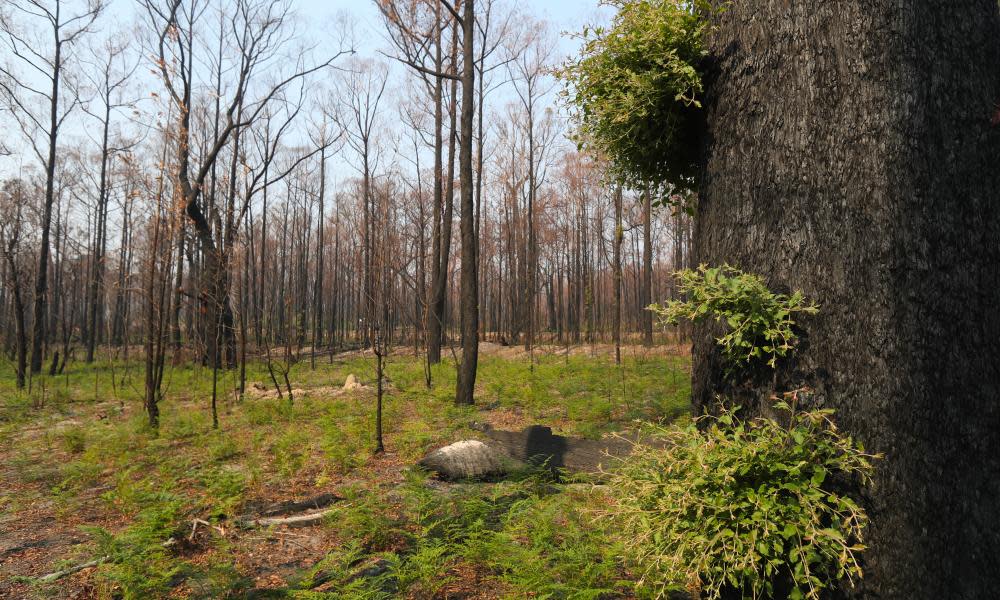Birds, insects, animal poo: citizen science search for data to make sense of bushfire devastation

Australians are being asked to join a mass citizen science program to photograph how the nation’s habitats and wildlife are responding in the wake of the unprecedented bushfire crisis.
The scale of the bushfires that have so far burned about 11m hectares across the country has ecologists and scientists in “uncharted territory” as they scramble to gather data to understand the devastation.
But the new citizen science project organised by the University of New South Wales could deliver essential data and observations that will feed into recovery efforts and future scientific papers.
Ecologist Casey Kirchhoff, of the UNSW Centre for Ecosystem Science, has started the project that lets people upload photographs using a free smartphone application called iNaturalist or its linked website.
Related: More than 100 threatened species hit hard by Australian bushfires, pushing many towards extinction
Kirchhoff, a PhD candidate studying climate change impacts on alpine plants, lost her own NSW home at Wingello, next to Morton National Park, when a fire razed the area on 4 January.
Preliminary government data suggests the fires burned through at least half the known habitats of more than 100 threatened species. More than a billion animals have likely perished, with scientists fearing some species have been pushed to extinction.
Prof Richard Kingsford, director of the UNSW Centre for Ecosystem Science, told Guardian Australia the project was a “really important opportunity to allow citizen science to meet rigorous science”.
We are not discriminating here – we want birds, insects, green shoots, animal poop, fungus
Casey Kirchhoff
“We want to learn what sort of animals and plants are bouncing back, and in which areas. We know the severity of the fires is extreme and extended into rainforest patches and into mangroves and places we hadn’t expected it to go.”
Kirchhoff said as some areas were showing signs of recovery, “we know there’s a lot out there that might not bounce back.
“That’s why we need people out there looking for us. We are not discriminating here – we want birds, insects, green shoots, animal poop, fungus … anything people think might be useful information. Even if it’s a tree that has burned to a crisp, that’s still useful.”
Kirchhoff kick-started the project despite the loss of her own home. She left the smallholding on 30 December with husband Michael and their three dogs Cookie, Evie and Billy, and an assortment of quails and chickens, including three chicks since named Spark, Ember and Flame. Fire eventually engulfed their home in an “inferno” on 4 January.
She said the new project was a welcome distraction from the devastation.
Kingsford said the information uploaded to the project was open source and available to any members of the public, as well as researchers from anywhere in the world.
He said understanding the way habitats were responding was “critical” and the information from the project could be used in multiple ways – from helping to target recovery efforts to informing longer-term scientific studies.
The government has announced an initial $50m to help research and recovery efforts, but Kingsford said that would be “sucked up pretty quickly”.
Related: 'Silent death': Australia's bushfires push countless species to extinction
“Using citizen science is a great opportunity and yes, it comes with challenges, but we are realising that those are more than outweighed by all the information we can gather from lots of people.”
Prof John Woinarski, of Charles Darwin University, applauded the efforts, and said: “It’s very important the recovery effort and the assessments are not just left to scientists.”
“We have had nothing of the scale and intensity of these fires and to some extent we are in uncharted territory.
“The issue we are facing is that there are so many things that need doing and we have subverted the status of so many species, resources, recovery plans and management actions and now we have to pick all these pieces up again. That’s an enormous task.”
How to get involved
No scientific or photographic experience is required to take part, said Kirchhoff, but people needed to ensure that places were safe to enter.
Would like to introduce a new citizen science project to help us monitor regrowth and recovery of Australian ecosystems across the *huge* extent of the fires. We need your help to (when it's safe) get back in see how plants / animals / fungi are doing. https://t.co/BKsmVyaZN1
— Will Cornwell (@will_cornwell) January 29, 2020
Anyone interested can register a free account at iNaturalist either online or through a free iNaturalist smartphone application. iNaturalist is a joint initiative of the California Academy of Sciences and the National Geographic Society.
Users then need to search for the “Environment Recovery Project: Australian Bushfires 2019-2020” and join that “project”.
Photographs can be uploaded with only simple descriptions. Some 40 people have already joined the project, uploading more than 160 images from Queensland, New South Wales, Victoria and South Australia.
The images already uploaded show deceased wallabies, surviving koalas, sprouting eucalypts, piles of bird bones and fungi.
A team of scientists work to identify the images for people who don’t know exactly what they are looking at.
Kirchhoff said they were hoping for a wide range of images from across different habitats all around bushfire-hit areas of Australia.
Every image had value, she said, whether it was a landscape photograph showing the state of the tree canopy, to closeups of sprouting trees, grasses, fungi and images of animals.

 Yahoo News
Yahoo News 
